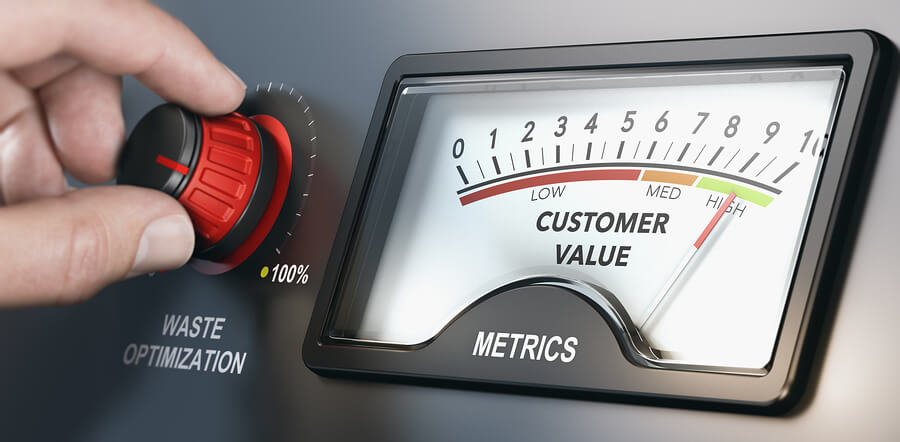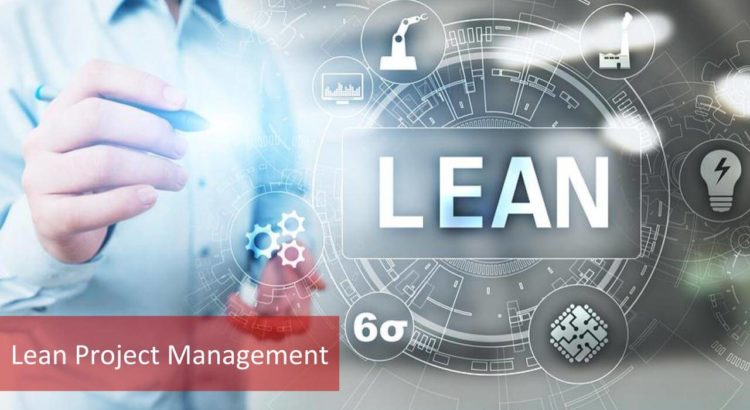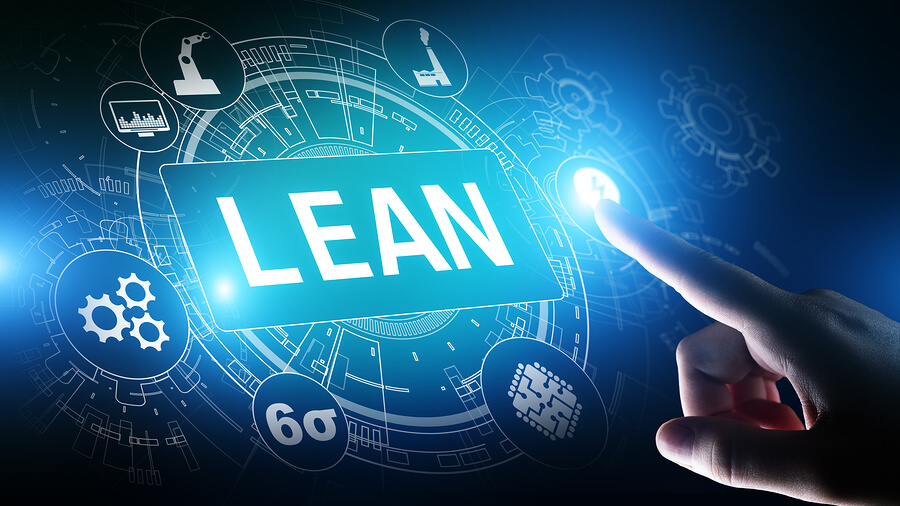Lean project management is one of the best practices of project management as an application of lean manufacturing principles. Therefore the objective of lean project management is to produce higher-value while reducing any kind of waste. Lean manufacturing principles were developed for improving the production processes of Toyota in the 1950s. The Project Management Institute expresses as: “To be Lean is to provide what is needed, when it is needed, with the minimum amount of materials, equipment, labor, and space.”
The main purpose of Lean Project Management is to reduce the working space, working hours, investment prices, and maintenance costs. As a result of this purpose, managers can enhance the productivity and effectiveness of the project team during on-going processes.
Our Free Agile Scrum Training describes the Agile and Scrum foundations and Lean Project Management as well. Enroll in our Free Agile Training now.

Lean Project Management uses Lean Manufacturing philosophy to cut the wastage of all kinds of resources and optimize product delivery rates further. We can give a brief look at the important clauses of this philosophy as below.
- Encouraging the employee to increase the performance rate in collaboration with striving to decrease the defect rate.
- To control and optimize costs, detect and eliminate steps and processes that have no contribution to the end product.
- Most importantly enhancing the efficiency of end to end production line to reduce the expense of inventory and deployment time.
Identifying wastes is a critical process before taking further steps to reach a lean working environment. Let’s dive into deeper what these wastes are according to Lean Management.
The Seven Types of Wastes in Lean Project Management
As a brief definition, anything that doesn’t have a positive impact on the functionality of the final product can be considered as a waste. Most noteworthy during the short term activities, reducing the wastage of resources and time leads to the production of higher value in the long term. Lean Project Management, which is originated from Lean Manufacturing, defines the seven types of wastes in detail as below.
- Inventory: It is the inventory you may overstock or order too early. It can turn your process into a chaotic situation and cause over costs.
- Waiting: This is directly related to a lack of planning. Then people and tasks start to wait for priors to continue during the project progress.
- Defects: This cause not only delays on the project outcome but also loss of money, resource, and reputation.
- Overproduction: Overproduction costs you more money and resource than you planned at the initiation phase. Besides, the main problem is this eventually reduces the value of your product.
- Motion: One of the root causes of motion waste is missing communication between project members. It is always better to keep project members focused on their duties.
- Transportation: Transportation is related to the physical locations of the project. If you have to perform the project in distributed locations, you need to figure out a way to keep the transportation requirement at a minimum.
- Over-processing: Unnecessary approval steps always become a heavy burden on the speed of the project. In agile project management methodology, it is better to deploy fast than to be perfect.

Implementing Lean Project Management Smoothly
Lean Project Management is applying lean concepts including lean manufacturing, lean thinking, and lean construction into the profession of project management. If you are willing to use Lean tools and techniques through Lean Project Management to your projects, there are some steps to take into consideration for a smooth transformation process.
1. Adapt Your Work-Flows to Lean Project Management
For a successful Lean Project Management transformation, it is obvious that the organization needs to adapt its flows with self-responsible team members who automatically take the necessary tasks from the queue at the right time. Consequently, the team can use Lean tools and techniques to increase the adaptation rate and to reach better results. Briefly, we can say that fine-tuning the existing operation regarding lean principles is a critical success factor for mounting cognizant of Lean Project Management.
2. Establish Team with Profound Knowledge
To conduct Lean Project Management processes efficiently, it is extremely important to create a well-equipped team that has deep knowledge of Lean Project Management values and principles. Team members have to be able to perform their duties with the help of their understanding of lean philosophy and tools.
It is smart for the organizations to start with internal training to develop their procedures and tailored methods that fit for actual requirements of their business. For that reason, the team can use the Kaizen workshop to identify, implement, and standardize new improvements to their processes.
3. Create Ownership Culture with Lean Project Management
Lean Project Management philosophy supports management and team to take full responsibility for products, processes, and business requirements. It is crucial to adopt the entire value stream by the members of the organization. With ownership culture, people contribute to the activity of removing wastes to improve efficiency and productivity.
4. Develop A Continuous Process
To identify and remove wastes that block the value generation with interrupting the flows or suspending further steps is crucial for maintaining a continuous workflow. Hence, one of the main duties of Lean Project Management facilitators is to be sure that the project proceeds without any interruptions or blockages.
There are some definitions below that give an idea to recognize a waste better.
- Unexpected delays for on-going tasks
- Obsolete inventory
- Unproductive steps and processes
- Overproduction
- High defect rate
- Unnecessary transportation costs
- Lack of resource utilization
Implementing A Software Project With Lean Project Management
The software development industry contains various types of project management methodologies. In recent years, some methodologies come to the forefront among software developers. These tools and methods serve the same purpose that is delivering high-quality software products and maintaining new features with shorter time-to-market time then the opponents.
First of all, Lean Project Management methodology tailored from Lean manufacturing principles to software development processes is written as a book by Mary Poppendieck and Tom Poppendieck in 2003. The book was published under the name “Lean Software Development”. Mary Poppendieck decided to write this book after achieving great success in implementing Lean manufacturing principles in her work to increase productivity.
Our Free Agile Scrum Training describes the Agile and Scrum foundations and Lean Project Management as well. Enroll in our Free Agile Training now.

The main thing you should be certain about Lean project management methodology is that it is one of the popular and important Agile methods. The agility of Lean Project Management depends on its iterative structure like other agile methods. Also, it is not easy to detect and improve unnecessary elements and tasks between active phases of a waterfall project which is conducted with sequential structure. Iterative and agile approaches are more suitable to improve the overall efficiency during work in progress.
The second thing about Lean Project Management is that Lean teams are self-organizing like other Agile frameworks and methodologies. They are cross-functional and they don’t directly bond with hierarchical structures.
For a better understanding of the value of Lean Project Management methodology in software development, if any member of the team faces a waste according to Lean, the team immediately stops working and starts to create a solution or an enhancement for that. This approach generates great and continuous value for time management.
The Five Core Principles of Lean Project Management
Lean project management principles mainly aim to improve the process which means that their focal point is increasing the efficiency of the process. The essential purpose of implementing these principles is to provide consistent and sustainable optimizations for the process stream. Lean Thinking is a term from James P. Womack and Daniel T. Jones who published in 1996 the book called ‘Lean Thinking: Banish Waste and Create Wealth in Your Corporation’.
The book Lean Thinking introduced five core principles:
1. Specify Value:
This principle tells about the customer perspective which is the dominating factor for defining the market value of a specific product. If you achieve to find the amount a customer is willing to pay for your service or product, it brings an accurate decision of the final pricing. Once you have a target price then you have to stick to that price with eliminating wastes and improving processes.
To understand the right value, teams continuously use refinement techniques to increase their insight into the customer’s mind.
2. Map The Value Stream:
A value stream means end-to-end activities for producing a product or project with all the steps. This principle drives to map all of the steps and activities of the value stream at first. Then the outcome can be analyzed to remove unnecessary steps or actions that cause waste of resources or compromise quality. After this process, a future-state map is created, which engages the creation of an improvement plan. This plan enables to continue with a transformation process between the current state and the future state.
3. Create Flow:
It is the process of improving the value stream by eliminating wastes according to value stream mapping. This allows improving the maturity of the value stream for the organization. Furthermore, there are three types of work in a value stream as value-added work, value-enabling work, and non-value-added work. Firstly, It is critical to eliminate non-value-added work. Secondly, you need to focus on value-enabling work to observe for elimination in the future.
4. Establish Pull:
The ideal state of value flow delivers the product with the demand from the customer. This reduces inventory costs, prevent overproduction, and optimizes resource usage. Every customer request triggers a value production.
5. Seek Perfection:
Sustainability and continuity are the aims of this principle. Setting standards and placing a lean culture serve to achieve perfection.
People are essential to keep the cultural transformation in any level of continuous improvement. The state of the value stream grows with the solutions for the impediments coming from people and also executed by them.

The Core Benefits of Lean Project Management
Lean Project Management provides important benefits for organizations. Some of them are listed below.
- Shorter delivery times: Every improvement on the project processes lead time savings during the production lifecycle
- Reduced inventory costs: In-time production allows organizations to work with low inventory amounts.
- Optimized workforce engagement: Ownership and pull culture encourages team members to contribute to resource optimization.
- High productivity: Once you remove blockages from the flow with Lean tools and techniques, it boosts productivity.
- High quality: The aim is defined as preventing the defects in Lean Project Management. This reduces the number of future defects and increases the overall health of products and services.
- Increased competitiveness: Organizations, which have adapted continuous improvement culture, eventually produce competitive results in the market.
- Great customer satisfaction: When you reach greater products and better delivery times with Lean Project Management that creates satisfied customers and a solid reputation for companies.
Our Free Agile Scrum Training has a lecture describing the Lean Technique. Enroll in our Free Agile Training now.

Popular Tools for Lean Project Management
Lean Project Management applications expose some tools for enhancing efficiency during project management activities and organizational transformation.
Value Stream Mapping
Professionals use this tool to analyze the current state of a value stream and define a plan to take necessary steps for the desired future state of production lifecycle of a certain product or service. It is also known as “material and information flow mapping”. It is a visual tool that shows all critical steps in a specific process together with the details of the time and volume taken by each step. There is also a close term called a value chain that describes all of the activities within a company.
Work Cells
Cross-functional and self-sufficient teams are the best examples of work cells. In some cases, the team can include physical equipment to its work cells. It depends on the industry and how to satisfy requirements.
One-piece flow
It is called iteration in software development. In manufacturing, a work team can apply this approach by focusing just one item or task until it finishes. To use the one-piece flow method, you have to establish a consistent production environment.
Kaizen
It is a concept that constantly improves all functions and refers to business activities that encompass all employees, from CEO to assembly line employees. Kaizen is the Japanese word for “improvement.” It also applies to processes such as purchasing and logistics, that have dependencies with external procedures and organizations. It has been applied in various fields and industries including healthcare, psychotherapy, life coaching, government, and banking.
Ths concept aims to eliminate waste by increasing the quality of standard programs and processes.
There are 5 fundamental principles for Kaizen that are included in every tool and behavior of this concept. The 5 principles are: Know your Customer, Let it Flow, Go to Gemba, Empower People, and Be Transparent. It is essential to apply these 5 principles in any organization to build a successful culture of Continuous Improvement and a milestone in the advancement of quality, productivity, and workforce management relationships.
A typical Kaizen event includes the following steps:
- Define goals and provide any necessary background.
- Observe and analyze the current state and release a plan for improvements.
- Fulfill improvements.
- Detect what doesn’t work and fix it with a simple solution.
- Share results and keep track of any follow-up items.
5S
5S stands for five phases including sort, set in order, shine, standardize, and sustain. Each S represents together a five-step process that can make a positive improvement for the overall efficiency of a business. Firstly, Sort, which is the first step of 5S, determines what is necessary for the working area or what can be removed without effect on the value of the work. Secondly, teams can execute their strategies set for remaining items after initial sorting. Thirdly, Shine includes maintenance work for the existing processes and items. Another step is to standardize that systematizes the actions taken in these steps and turns them into regular habits. The last step is about the continuity of performing habits. Finally, A daily activity to remind people the 5S can be set for protecting achievements.
PDCA
It is an iterative approach that consists of four stages called “Plan”, “Do”, “Check”, and “Act”. This method is used for the control and continuous improvement of business processes and products. It provides a clear, powerful, and fast approach to provide solutions for problems by allowing to test solutions and assess results in a waste-reducing cycle while effectively managing change.
PDCA proposes a methodical way to find the fitting answers to a problem with the four stages described below.
- Plan: Firstly, you need to understand and identify what the problem is about, or the opportunity that you want to use for achieving the desired results. Then continue with determining the objectives and processes required to present expected quality levels.
- Do: The next step is to conduct a testing practice for the identified potential solution. This will allow you to observe test results whether they meet the quality criteria or not. If you notice a problem, you can make changes in your plan that cost low in this early step.
- Check: At this stage, you gather and analyze the results of the prior step more deeply. If you didn’t get the expected results, you would return to Plan. When the outcomes satisfy you, then you proceed to Act. If you repeat the method more than once, putting all gathered data into a chart is a better way to see differentiations between the cycles.
- Act: This final step is where you implement your solution or deploy the solution package. This step is also called as adjust. At the end of the actions taken in this phase, the process becomes better with tailored instructions, standards, and features. During the further implementations of PDCA, the facilitator has to check repetitive actions and solutions and prevent those in order to avoid resource wasting.
How Lean Differs From Other Agile Methods
Lean Project Management has a strong connection with the other Agile methodologies. Most of them put customer satisfaction at the center of their value chain. They all designed over the iterative structure and they aim to produce frequent increments rather than huge release packages. Most importantly, it is substantial to understand the differences and similarities between Lean Project Management and Agile methodology due to guarantee the feasible application and to obtain effective and efficient project management process.
However, Lean Project Management is quite different from other Agile methodologies in some fundamental angles.
- Lean Project Management focuses on eliminating wastes both in short term and long term to make process improvements which result in meeting the customer requirements effectively and accurately.
- Lean Project Management provides insight for all levels of the organizations rather than a specific department like software development. All units can apply Lean principles to their works to gain greater benefit as a whole. Lean culture supports the organizations to improve overall efficiency and entire phases of processes.
- One of the main purposes of Lean Project Management is to avoid variations and rework as far as possible. It demonstrates various actions with a wide range of tools to minimize this kind of cost. On the other hand, the agile mindset welcomes corrections as usual opportunities to enhance the technical experience of the team.
Conclusion
As a result of this article, you can decide about implementing Lean Project Management if there are matching benefits to your business and technical requirements. This is a mature methodology for decades that demonstrates its efficiency and value numerous times. In the manufacturing industry, organizations use this methodology to gain a competitive advantage in the global market. And also it gave inspirations to most of the trending agile frameworks and methodologies about optimizing resources with maximum percentages. Moreover, Lean Project Management simplifies the project lifecycle to provide a clear and smooth understanding of the overall status of project health.
Author
 Tayfun Odabas, PMP, PSM, PSPO is an IT Project Manager with more than ten years of working experience in Frankfurt. He participated in delivering large transformation projects that applied in different departments of broad-scale organizations. He also obtained strong agile process knowledge by supporting and leading 3 agile teams of 3 different enterprise products as a scrum product owner. Tayfun is aiming to utilize his strong prioritizing skills and analytical ability to achieve the goals of his company with significant results. When he’s not designing and directing software development projects, he likes to do board sports.
Tayfun Odabas, PMP, PSM, PSPO is an IT Project Manager with more than ten years of working experience in Frankfurt. He participated in delivering large transformation projects that applied in different departments of broad-scale organizations. He also obtained strong agile process knowledge by supporting and leading 3 agile teams of 3 different enterprise products as a scrum product owner. Tayfun is aiming to utilize his strong prioritizing skills and analytical ability to achieve the goals of his company with significant results. When he’s not designing and directing software development projects, he likes to do board sports.


